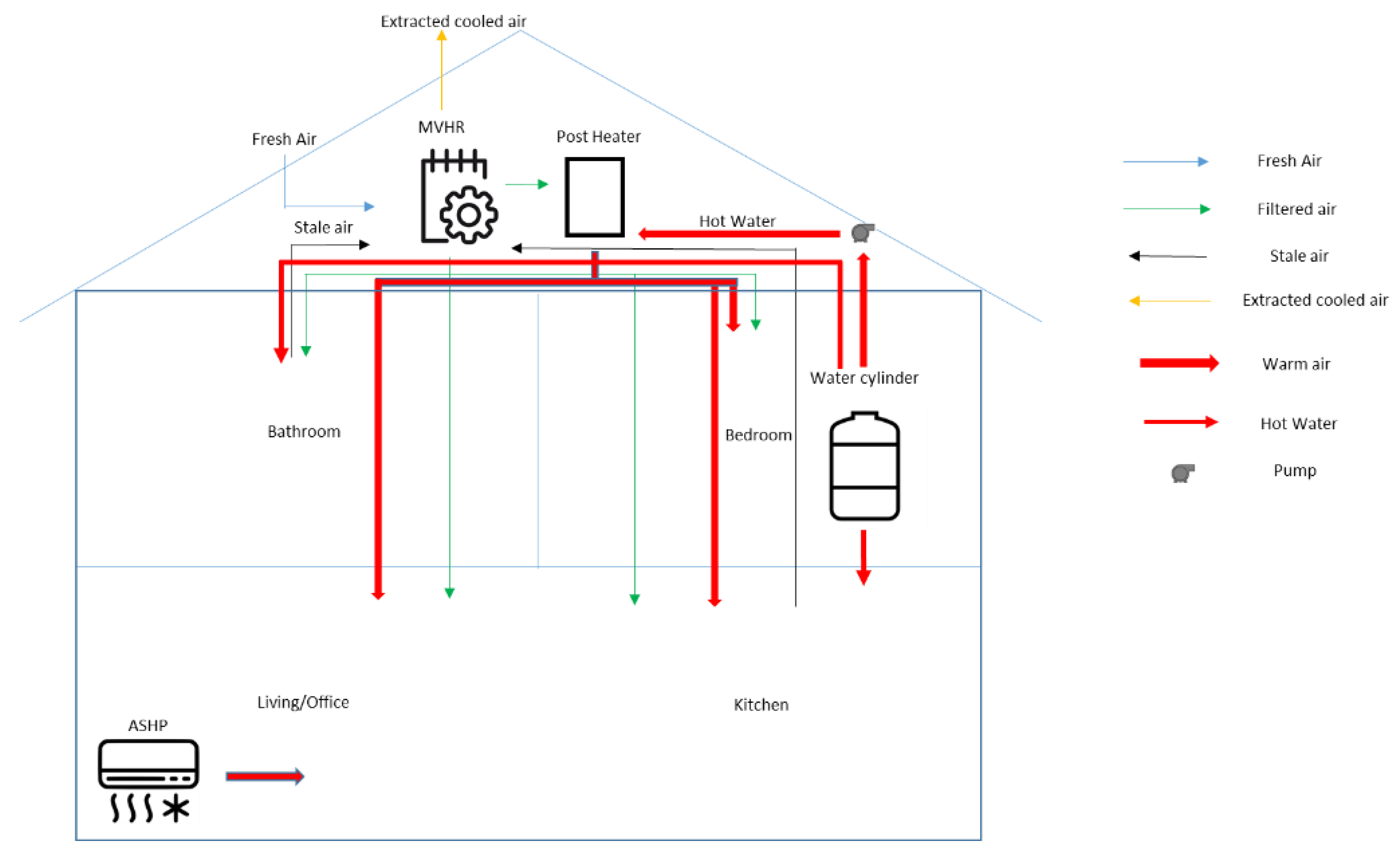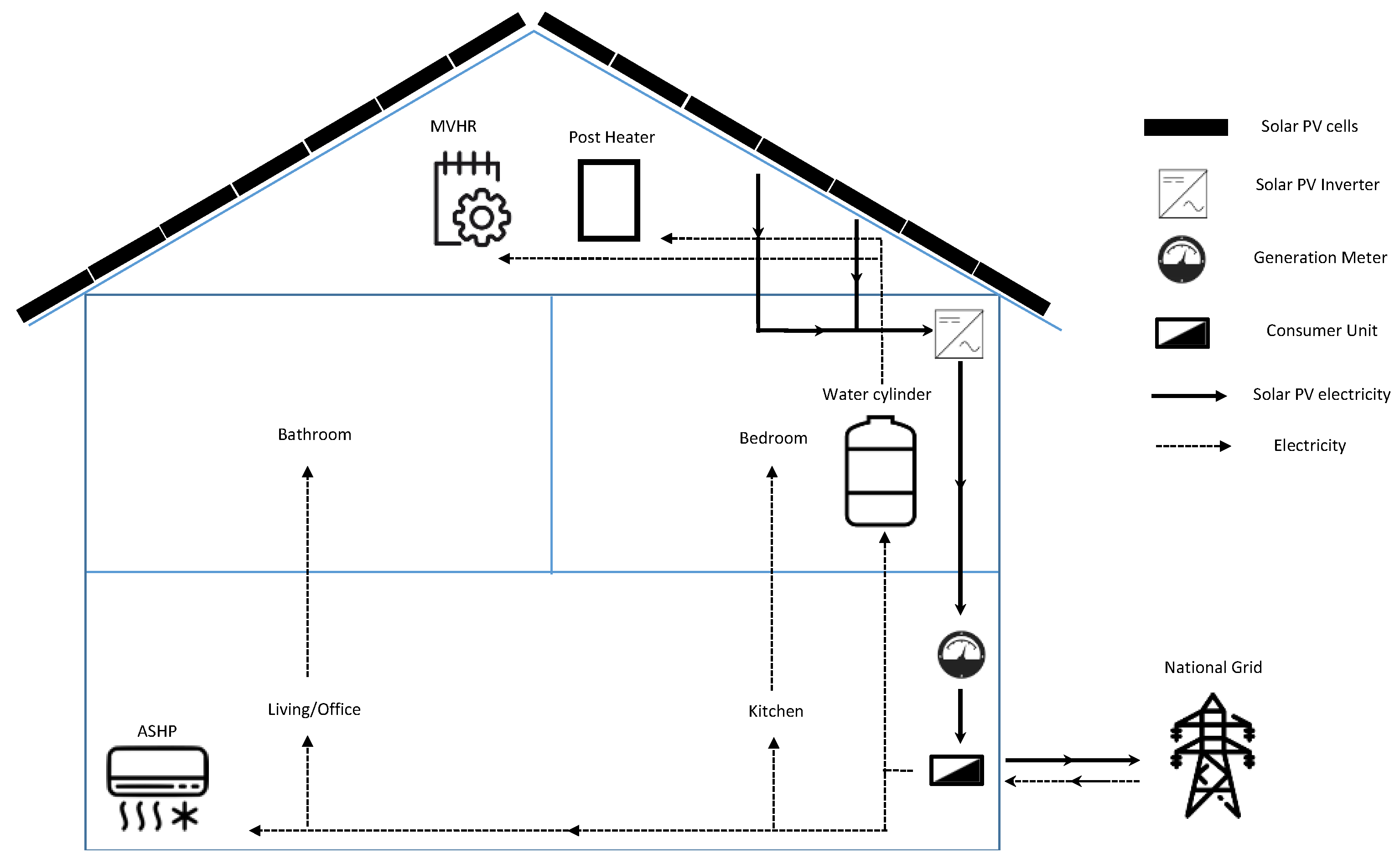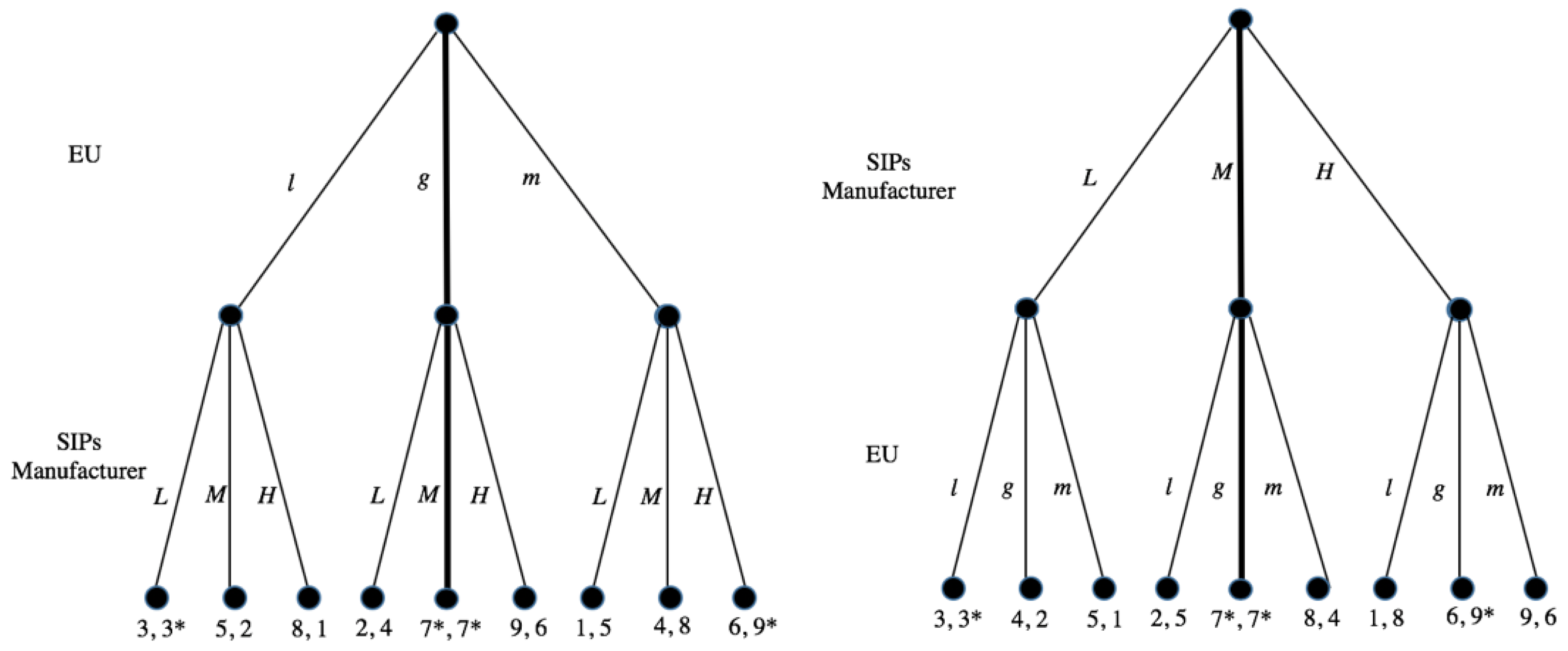The Potential of Structurally Insulated Panels (SIPs) to Supply Net Zero Carbon Housing
Abstract
:1. Introduction
2. Research Methodology
3. Data Collection
3.1. Case Study Selection and Justification
3.2. Case Study
3.2.1. Power
3.2.2. Space Heating, Ventilation, Cooling and Hot Water
3.2.3. Occupants and Lifestyle
3.3. Energy Use
3.4. Occupant Survey
4. Analysis
4.1. Energy Use
4.2. Renewable Technologies
Achieving nZEB across the UK and EU Member States
4.3. Game Theory: Incentives, Market Design and Policy
- Low investment (L), which corresponds to the SIPs manufacturer continuing to self-promote and self-finance SIPs, working on a production to order basis. The manufacturer is unlikely to be able to meet significant increases in demand in the near future.
- Medium investment (M), which corresponds to the SIPs manufacturer gradually increasing production and investing in larger manufacturing facilities. The manufacturer also seeks external investment to increase capacity.
- High investment (H), which involves large scale investment into SIPs across numerous countries with significant external funding sought. The capacity of the manufacturer is increased dramatically.
- Limited support (l) from the UK/EU, which provides very limited prioritisation and advocation of SIPs. Parties commissioning new buildings receive little encouragement to prioritise this type of SIPs.
- Gradual support (g) from the UK/EU, which corresponds with a gradual increase in regulatory and financial support for SIPs. We can also consider an alternative interpretation of gradual support where the level of support is initially high and decreases during the policy period as the market establishes itself. It will be demonstrated in Section 4.3.3. that our main results are robust to this alternative definition.
- Maximum support (m) from the UK/EU, which involves major and immediate changes to UK/EU policy to support and prioritise SIPs.
- i.
- For any choice of the manufacturer, the manufacturer receives a higher payoff when the UK/EU provides greater support for SIPs.
- ii.
- For any choice of the UK/EU, the manufacturer earns a higher payoff when the manufacturer’s level of investment is consistent with the level of support provided by the UK/EU, than when the manufacturer’s commitment differs. Consistent refers to both parties choosing the same degree of support/investment.
- iii.
- For any choice of the UK/EU, if the manufacturer chooses a different level of investment than the corresponding level of support from the UK/EU, then:
- a.
- The manufacturer earns a lower payoff when the commitment of the two parties differs more significantly.
- b.
- The manufacturer earns a higher payoff from over-investing than under-investing.
- c.
- The manufacturer earns a higher payoff in the outcome: (H, g) than (L, m). Note that principle iii(c) enables us to fully characterize the preference ranking of the manufacturer but is not necessary. All of the subsequent results are unaffected when this principle is removed. We discuss how the results are robust to relaxing many of the guiding principles in Section 4.3.3.
- i.
- For any choice of the UK/EU, the UK/EU receives a higher payoff when the manufacturer chooses a higher level of investment.
- ii.
- For a given choice of the manufacturer, the UK/EU never prefers to choose maximum support over either gradual or limited support, due to the prohibitive costs and risks involved in providing maximum support for a specific type of construction. Furthermore, the UK/EU prefers (M, g) over (H, m).
- iii.
- The UK/EU earns a higher payoff when it chooses the same level of commitment as the manufacturer (except the case of high investment because maximum support is prohibitively costly, and the UK/EU prefers gradual investment).
- iv.
- If the support of the UK/EU is consistent with the investment of the manufacturer, the UK/EU prefers gradual support over limited support.
4.3.1. Simultaneous Decision-Making
4.3.2. Sequential Decision-Making and Market Design
4.3.3. Discussion, Policy Implications and Robustness
5. Conclusions and Policy Implications
Author Contributions
Funding
Institutional Review Board Statement
Informed Consent Statement
Data Availability Statement
Acknowledgments
Conflicts of Interest
Nomenclature
| ALDREN | ALiance for Deep RENovation in Buildings |
| ASHP | Air Source Heat Pump |
| Beem-UP | Building Energy Efficiency for Massive market Uptake |
| BRP | Building Renovation Passports |
| CCTV | Closed Circuit Television |
| CO2e | Carbon Dioxide and Equivalents |
| CO-HERENO | Collaboration for Housing Nearly Zero-Energy Renovation |
| DIPS | Dragon Intelligent Panel System |
| Eprim | Primary Energy |
| Esolar | Solar Energy |
| EPBD | Energy Performance of Buildings Directive |
| EU | European Union |
| GFA | Gross Floor Area |
| MMC | Modern Methods of Construction |
| M&E | Mechanical and Electrical |
| MgO | Magnesium Oxide |
| MVHR | Mechanical Ventilation and Heat Recovery |
| NeZeR | Nearly Zero Energy Renovation |
| NHER | National Home Energy Rating |
| NZC | Net Zero Carbon |
| nZEB | Nearly Zero Energy Building |
| OSB | Oriented Strand Board |
| SIPs | Structurally Insulated Panels |
| SPV | Solar Photovoltaics |
| WiFi | Wireless Fidelity |
| 4RinEU | Renovation of Residential buildings in EU |
Appendix A
Appendix A.1. Primary Energy Consumption
Appendix A.2. Renewable Technologies
Appendix B
| EU | ||||
| Limited Support | Gradual Support | Maximum Support | ||
| SIPs Manufacturer | Low Investment | C | D | E |
| Medium Investment | B | G | H | |
| High Investment | A | F | I | |
- i.
- C < D < E; B < G < H; A < F < I
- ii.
- A, B < C; D, F < G; H, E < I
- iii.
- a.
- A < B < C, E < H < I
- b.
- D < F
- c.
- E < F
- (a)
- The payoff matrix presented in Figure 4 represents the preference ranking that satisfies the guiding principles of the EU’s incentives.
- (b)
- The payoff matrix is not unique. That is, there exists other preference rankings that satisfy these principles. However, any other preference ranking that does satisfy these general principles yields the exact same Nash equilibrium. Therefore, the equilibrium is robust to all possible permutations.
| EU | ||||
| Limited Support | Gradual Support | Maximum Support | ||
| SIPs Manufacturer | Low Investment | C | B | A |
| Medium Investment | E | G | D | |
| High Investment | H | I | F | |
- i.
- C < E < H; B < G < I; A < D < F.
- ii.
- A < B, C; D < G, E; F < I, H; F < G.
- iii.
- A, B < C; D, E < G; H < I.
- iv.
- C < G
- C < B or A,
- G < E or D,
- I < H or F.
- Step 1:
- Given the conditional choices of the EU, the manufacturer must choose their action. Therefore, there exists only three possible equilibrium outcomes of the game: (Low, limited), (Medium, gradual), (High, gradual) and the manufacturer must choose the alternative that yields the highest payoff. In the language of the payoff ordering in the proof of Claim 1, to ensure that the outcome is an equilibrium: (Medium, gradual), we require: G > F and G > C.
- Step 2:
- To show that G > F, we use Guiding Principle I(ii).
- Step 3:
- From Guiding Principle I(i), it must be true that: C < D. From Guiding Principle I(ii), it must be true that D < G. Therefore, combining these two restrictions ensures C < G.
References
- BPIE Nearly Zero Energy Buildings Definitions across Europe (2010) Energy. 2010. Available online: https://www.bpie.eu/wp-content/uploads/2015/09/BPIE_factsheet_nZEB_definitions_across_Europe.pdf (accessed on 15 February 2022).
- Cambridge Institute for Sustainability Leadership. 2018. Available online: https://www.cisl.cam.ac.uk/resources/low-carbon-transformation-publications/renovation-roadmap (accessed on 15 February 2022).
- Hopfe, C.; McLeod, R.S. The Passivhaus Designer’s Manual; Routledge: Oxfordshire, UK, 2015. [Google Scholar] [CrossRef]
- Maruejols, L.; Ryan, D.L.; Young, D. Eco-houses and the environment: A case study of occupant experiences in a cold climate. Energy Build. 2013, 62, 368–380. [Google Scholar] [CrossRef]
- Mlecnik, E.; Visscher, H.; van Hal, A. Barriers and opportunities for labels for highly energy-efficient houses. Energy Policy 2010, 38, 4592–4603. [Google Scholar] [CrossRef]
- Mahdavi, A.; Doppelbauer, E.-M. A performance comparison of passive and low-energy buildings. Energy Build. 2010, 42, 1314–1319. [Google Scholar] [CrossRef]
- Zeng, C.; Liu, S.; Shukla, A.; Yang, B. Identifying the occupant’s satisfaction and awareness for the performance of Eco houses in the United Kingdom. J. Build. Eng. 2018, 18, 281–291. [Google Scholar] [CrossRef]
- Akintoye, A.; Goulding, J.S.; Zawdie, G. Construction Innovation and Process Improvement; Wiley-Blackwell: Hoboken, NJ, USA, 2012; pp. 1–17. [Google Scholar] [CrossRef] [Green Version]
- Farreny, R.; Oliver-Solà, J.; Montlleó, M.; Escribà, E.; Gabarrell, X.; Rieradevall, J. Transition towards Sustainable Cities: Opportunities, Constraints, and Strategies in Planning. A Neighbourhood Ecodesign Case Study in Barcelona. Environ. Plan. A Econ. Space 2011, 43, 1118–1134. [Google Scholar] [CrossRef]
- Van Waeyenberge, E. Crisis? What crisis? A critical appraisal of World Bank housing policy in the wake of the global financial crisis. Environ. Plan. A Econ. Space 2018, 50, 288–309. [Google Scholar] [CrossRef] [Green Version]
- Belussi, L.; Barozzi, B.; Bellazzi, A.; Danza, L.; Devitofrancesco, A.; Fanciulli, C.; Ghellere, M.; Guazzi, G.; Meroni, I.; Salamone, F.; et al. A review of performance of zero energy buildings and energy efficiency solutions. J. Build. Eng. 2019, 25, 100772. [Google Scholar] [CrossRef]
- Lokeshgupta, B.; Sivasubramani, S. Cooperative game theory approach for multi-objective home energy management with renewable energy integration. IET Smart Grid 2019, 2, 34–41. [Google Scholar] [CrossRef]
- Mondal, A.; Misra, S.; Obaidat, M.S. Distributed Home Energy Management System With Storage in Smart Grid Using Game Theory. IEEE Syst. J. 2017, 11, 1857–1866. [Google Scholar] [CrossRef]
- Marzband, M.; Javadi, M.; Domínguez-García, J.L.; Moghaddam, M.M. Non-cooperative game theory based energy management systems for energy district in the retail market considering DER uncertainties. IET Gener. Transm. Distrib. 2016, 10, 2999–3009. [Google Scholar] [CrossRef] [Green Version]
- Liu, Y.; Hu, S.; Huang, H.; Ranjan, R.; Zomaya, A.Y.; Wang, L. Game-Theoretic Market-Driven Smart Home Scheduling Considering Energy Balancing. IEEE Syst. J. 2017, 11, 910–921. [Google Scholar] [CrossRef] [Green Version]
- Zhu, Z.; Lambotharan, S.; Chin, W.H.; Fan, Z. A Game Theoretic Optimization Framework for Home Demand Management Incorporating Local Energy Resources. IEEE Trans. Ind. Informatics 2015, 11, 353–362. [Google Scholar] [CrossRef] [Green Version]
- Sheikhi, A.; Rayati, M.; Bahrami, S.; Ranjbar, A.M. Integrated Demand Side Management Game in Smart Energy Hubs. IEEE Trans. Smart Grid 2015, 6, 675–683. [Google Scholar] [CrossRef]
- Srinivasan, D.; Rajgarhia, S.; Radhakrishnan, B.M.; Sharma, A.; Khincha, H. Game-Theory based dynamic pricing strategies for demand side management in smart grids. Energy 2017, 126, 132–143. [Google Scholar] [CrossRef]
- Lord, A.; Gu, Y. Can the market be tamed? A thought experiment on the value(s) of planning. Environ. Plan. A Econ. Space 2019, 51, 11–24. [Google Scholar] [CrossRef]
- Samsura, D.A.; van der Krabben, E.; van Deemen, A. A game theory approach to the analysis of land and property development processes. Land Use Policy 2010, 27, 564–578. [Google Scholar] [CrossRef]
- Tsang, S.W.; Jim, C.Y. Game-Theory Approach for Resident Coalitions to Allocate Green-Roof Benefits. Environ. Plan. A Econ. Space 2011, 43, 363–377. [Google Scholar] [CrossRef]
- Branco, G.; Lachal, B.; Gallinelli, P.; Weber, W. Predicted versus observed heat consumption of a low energy multifamily complex in Switzerland based on long-term experimental data. Energy Build. 2004, 36, 543–555. [Google Scholar] [CrossRef]
- Santin, O.G. Behavioural Patterns and User Profiles related to energy consumption for heating. Energy Build. 2011, 43, 2662–2672. [Google Scholar] [CrossRef]
- Guerra Santin, O. Actual Energy Consumption in Dwellings: The Effect of Energy Performance Regulations and Occupant Behaviour; IOS Press: Amsterdam, The Netherlands, 2010. [Google Scholar]
- Haas, R.; Auer, H.; Biermayr, P. The impact of consumer behavior on residential energy demand for space heating. Energy Build. 1998, 27, 195–205. [Google Scholar] [CrossRef]
- Guardigli, L. Comparing the Environmental Impact of Reinforced Concrete and Wooden Structures; Woodhead Publishing: Sawston, UK, 2014; pp. 407–433. [Google Scholar] [CrossRef]
- D’Agostino, D.; Mazzarella, L. What is a Nearly zero energy building? Overview, implementation and comparison of definitions. J. Build. Eng. 2019, 21, 200–212. [Google Scholar] [CrossRef]
- Ramesh, T.; Prakash, R.; Shukla, K.K. Life cycle energy analysis of buildings: An overview. Energy Build. 2010, 42, 1592–1600. [Google Scholar] [CrossRef]
- Attia, S.; Eleftheriou, P.; Xeni, F.; Morlot, R.; Ménézo, C.; Kostopoulos, V.; Betsi, M.; Kalaitzoglou, I.; Pagliano, L.; Cellura, M.; et al. Overview and future challenges of nearly zero energy buildings (nZEB) design in Southern Europe. Energy Build. 2017, 155, 439–458. [Google Scholar] [CrossRef]
- D׳agostino, D. Assessment of the progress towards the establishment of definitions of Nearly Zero Energy Buildings (nZEBs) in European Member States. J. Build. Eng. 2015, 1, 20–32. [Google Scholar] [CrossRef]
- Trebut, F.; Warmuth, H.; Supper, S.; Hilderson, W.; Artola, I.; Thuring, M.; Van Holm, M.; Münke, R.; Pannier, P.; Bensmann, K.; et al. Barriers and Opportunities for Business Collaboration in the nZEB Single-Family Housing Renovation Market. COHERENO D3.2 Version 1.0. COHERENO (Collaboration for Housing Nearly Zero-Energy Renovation). 2014. Available online: https://www.narcis.nl/publication/RecordID/oai:tudelft.nl:uuid%3Ab9fc01d5-500b-467b-8630-c5aba1d45a8a (accessed on 23 May 2019).
- Evans, V.; Kerr, K. How Modern Methods of Construction Can Deliver ‘More’ through the Planning System, Solving the Housing Crisis. 2018. Available online: https://www.arup.com/perspectives/publications/research/section/how-modern-methods-of-construction-can-deliver-more-through-the-planning-system (accessed on 19 June 2019).
- Local, D. for C. Fixing our Broken Housing Market, Department for Communities and Local Government. 2017. Available online: https://assets.publishing.service.gov.uk/government/uploads/system/uploads/attachment_data/file/590464/Fixing_our_broken_housing_market_-_print_ready_version.pdf (accessed on 19 June 2019).
- CITB (Construction Industry Training Board). The Impact of Modern Methods of Construction on Skills Requirements for Housing. Available online: https://www.gov.uk/government/publications/impact-of-modern-methods-of-construction-on-skills-requirements-for-housing-research-summary (accessed on 21 March 2021).
- BRE. Available online: https://www.bregroup.com/wp-content/uploads/2019/10/Briefing-note-on-derivation-of-PE-factors-V1.3-01-10-2019.pdf (accessed on 26 November 2022).







| Country | 2021 nZEB Standard Eprim kWh/m2/Year | Country | 2021 nZEB Standard Eprim kWh/m2/Year |
|---|---|---|---|
| Austria | 160 [1] | Italy | Available with no specific values set |
| Belgium | 45 [1] | Latvia | 95 [1] |
| Bulgaria | 30–50 [1] | Lithuania | Under development |
| Croatia | 33–41 [1] | Luxembourg | Under development |
| Cyprus | 100 [1] | Malta | 40 [1] |
| Czech Republic | Under development | Netherlands | Under development |
| Denmark | 20 [1] | Poland | 60–75 [1] |
| Estonia | 50–100 [1] | Portugal | Under development |
| Finland | Under development | Romania | 93–217 [1] |
| France | 40–65 [1] | Slovakia | 32–54 [1] |
| Germany | Under development | Slovenia | 45–50 [1] |
| Greece | Under development | Spain | Under development |
| Hungary | 50–72 [1] | Sweden | 30–75 [1] |
| Ireland | 45 [1,27] | UK | 44 [1] |
Publisher’s Note: MDPI stays neutral with regard to jurisdictional claims in published maps and institutional affiliations. |
© 2022 by the authors. Licensee MDPI, Basel, Switzerland. This article is an open access article distributed under the terms and conditions of the Creative Commons Attribution (CC BY) license (https://creativecommons.org/licenses/by/4.0/).
Share and Cite
Finnegan, S.; Edwards, R.; Al-Derbi, B.; Campbell, I.; Fulton, M. The Potential of Structurally Insulated Panels (SIPs) to Supply Net Zero Carbon Housing. Buildings 2022, 12, 2081. https://doi.org/10.3390/buildings12122081
Finnegan S, Edwards R, Al-Derbi B, Campbell I, Fulton M. The Potential of Structurally Insulated Panels (SIPs) to Supply Net Zero Carbon Housing. Buildings. 2022; 12(12):2081. https://doi.org/10.3390/buildings12122081
Chicago/Turabian StyleFinnegan, Stephen, Robert Edwards, Bushra Al-Derbi, Iona Campbell, and Matt Fulton. 2022. "The Potential of Structurally Insulated Panels (SIPs) to Supply Net Zero Carbon Housing" Buildings 12, no. 12: 2081. https://doi.org/10.3390/buildings12122081





